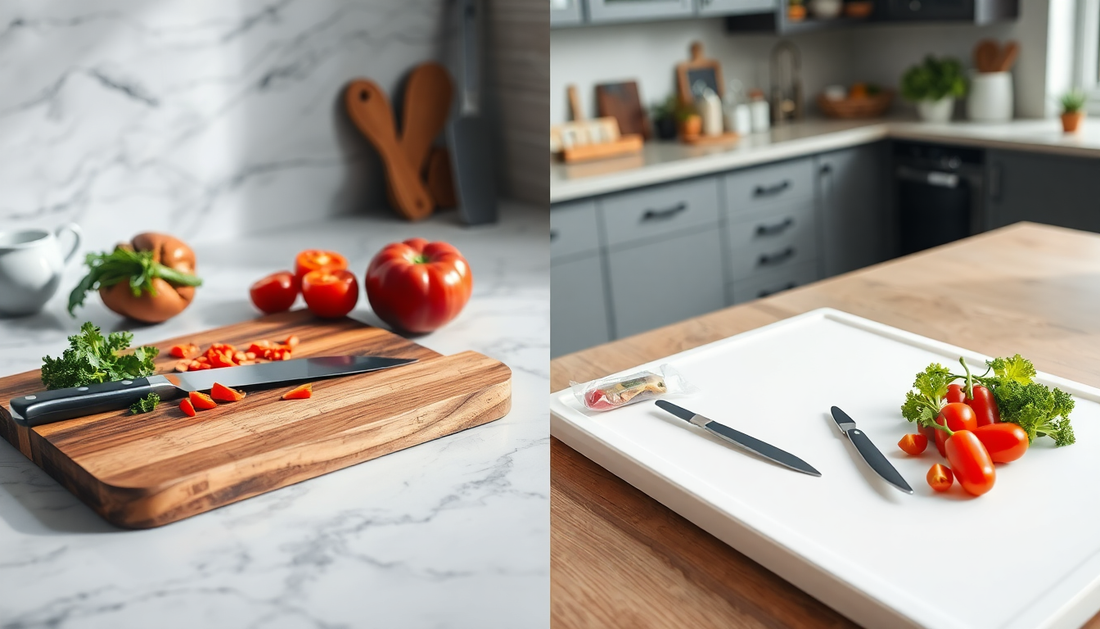
Cutting Board vs. Plastic Board: Which Is Better?
Share
When it comes to food preparation, the choice between a wooden cutting board and a plastic one can have a significant impact on your kitchen experience. As the owner of Tayfus, a shop specializing in high-quality wood grill boards and custom cutting boards, I've had the opportunity to observe the pros and cons of each option. In this blog post, I'll dive into the key factors to consider when selecting the best cutting board for your needs.
Durability and Longevity
One of the primary considerations when choosing a cutting board is its durability and longevity. Wooden cutting boards are renowned for their exceptional strength and resilience. They can withstand years of heavy use without showing significant signs of wear and tear. The natural grain and texture of wood also help to conceal minor scratches and nicks, giving your cutting board a timeless, rustic appearance.
In contrast, plastic cutting boards are generally more susceptible to visible damage over time. While they may be easier to clean and maintain, the surface can become scarred and discolored with repeated use. This can not only detract from the overall aesthetic of your kitchen but also compromise the board's functionality.
Hygiene and Bacteria Resistance
When it comes to food safety, the debate between wooden and plastic cutting boards often centers around their ability to resist the growth of harmful bacteria. Historically, there has been a perception that wooden boards are more prone to harboring bacteria, as the porous nature of the material can provide a breeding ground for microorganisms.
However, recent studies have shown that this may not be the case. Properly maintained wooden cutting boards can actually be more resistant to bacterial growth than their plastic counterparts. The natural antimicrobial properties of wood, combined with the ability of the surface to self-heal, can help to minimize the risk of cross-contamination.
Plastic boards, on the other hand, can be more susceptible to deep scratches and grooves, which can trap food particles and bacteria. These small crevices can be challenging to clean thoroughly, potentially leading to the buildup of harmful microorganisms.
Ease of Cleaning and Maintenance
When it comes to cleaning and maintenance, both wooden and plastic cutting boards have their own unique considerations. Plastic boards are generally considered easier to clean, as they can be washed in the dishwasher or quickly scrubbed with soap and water. The smooth, non-porous surface of plastic makes it less likely to harbor lingering food particles or stains.
Wooden cutting boards, however, require a bit more care and attention. They should be hand-washed with mild soap and water, and it's essential to avoid submerging them in water for extended periods, as this can cause the wood to swell and warp. Regular oiling and conditioning of the wood can help to maintain its appearance and prevent cracking or splitting.
Aesthetic Appeal and Versatility
When it comes to the visual appeal of your kitchen, the choice between a wooden or plastic cutting board can have a significant impact. Wooden cutting boards, with their natural grain and warm tones, can add a touch of rustic charm and elegance to your kitchen. They can also be customized with various wood types, shapes, and sizes to complement your decor.
Plastic cutting boards, on the other hand, tend to have a more utilitarian appearance. While they can come in a variety of colors and designs, they may not have the same level of visual interest as their wooden counterparts. However, plastic boards can be more versatile in terms of their ability to be used for a wider range of tasks, such as chopping meat, vegetables, and even serving as a trivet for hot dishes.
Environmental Considerations
In today's eco-conscious world, the environmental impact of our choices is an important factor to consider. Wooden cutting boards are generally seen as the more sustainable option, as they are made from a renewable resource that can be responsibly sourced and harvested.
Plastic cutting boards, on the other hand, are derived from non-renewable fossil fuels and can contribute to the growing problem of plastic waste. While some plastic boards may be recyclable, their production and disposal can have a more significant environmental footprint.
The Verdict: Choosing the Right Cutting Board
When it comes to selecting the best cutting board for your kitchen, there is no one-size-fits-all solution. Both wooden and plastic cutting boards have their own unique advantages and disadvantages, and the choice ultimately depends on your personal preferences, needs, and priorities.
If you value durability, natural antimicrobial properties, and a visually appealing addition to your kitchen, a high-quality wooden cutting board from Tayfus may be the ideal choice. Our boards are crafted from the finest materials and designed to last for years, providing a functional and stylish solution for all your food preparation needs.
On the other hand, if ease of cleaning and versatility are your top concerns, a plastic cutting board may be the more practical option. Just be mindful of the potential for bacterial buildup and the environmental impact of your choice.
Ultimately, the decision between a wooden or plastic cutting board is a personal one, and it's important to weigh the various factors to determine which option best suits your kitchen and your cooking style. Regardless of your choice, investing in a durable, well-maintained cutting board is an essential step in ensuring the safety and enjoyment of your culinary adventures.
